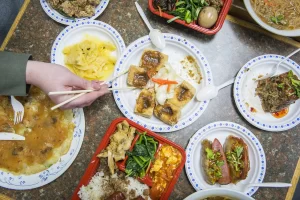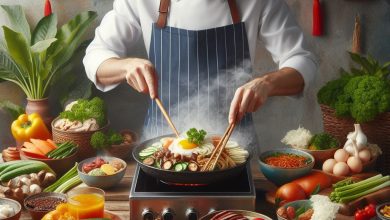Street food in China – simple and delicious

Chinese cuisine is rich and varied. Many of her recipes surpass the delights of French cuisine in their complexity and elegance. However, a tourist visiting the Celestial Empire is unlikely to taste gourmet cuisine in expensive restaurants every day.
But street snacks are presented in China literally at every step and are available to many. They amaze with their variety and are presented in any price category. In addition, the preparation of many dishes turns into a real show. Most often, street snacks are sold on tourist streets or in areas with traditional buildings – hutongs. They are sold from stalls and carts, carried on bicycles or carried in baskets. On tourist streets near food stalls, small tables are often placed for customers.
Street food traditions in China are very ancient. There have always been quite a lot of poor and familyless people in the country who did not have the opportunity to cook a full meal at home. Trade has also been developed in China for a long time. If a person did not have enough money or time to visit a tavern, then at his service there were stalls of street vendors and dishes that were prepared in just a few minutes. There were also a lot of takeaway snacks. However, with the development of the culture of street food, scientists and poets often became its fans, often glorifying their favorite dishes in their works.
Spicy and salty snacks
Shaokao were known in China during the Han Dynasty (206 BC – 220 AD). It is believed that this dish appeared in China under the influence of nomads who were very fond of fried meat. A whole series of foreign steppe dynasties on the Chinese throne contributed to the strengthening of the position of this snack in the Middle Kingdom.

The modern revival of shaokao began in the 1980s, at the instigation of the Uighurs. The growing prosperity of the Chinese, the greater availability of food, including meat, have made shaokao a very common and popular street snack. There are many regional variations on the shaokao theme.
This Chinese street snack is a wooden stick with ingredients strung on it. They can be deep-fried or charcoal-fried over a strong open fire. The choice of ingredients is huge. It can be pre-marinated chicken hearts, meat, shrimp, whole squid or their tentacles, shellfish.
There are also more exotic versions of kebabs: with whole crabs strung on them. Interestingly, seafood snacks can be found not only in seaside cities, but also in the depths of the continent, for example, in Xian or Guangxi. At the same time, a whole crab on a skewer is a rather expensive dish for tourists, and a shish kebab with tentacles is a common folk snack.
However, vegetarians can also find options for kebabs suitable for them: dough balls sprinkled with sesame seeds, shaokao from cabbage, tofu or mushrooms. It is best to take several sticks with different flavors. Such street food is not designed to saturate a person, it is an original light snack. The Chinese often like to take such kebabs as a beer snack.
Jianbing egg pancakes
The simplest and most common Chinese street snack is pancake with fried egg. The dough is poured onto a heated metal circle, baking sheet or pan. Then, an egg is broken into the pancake being prepared, sprinkled with finely chopped green onions. Sometimes, in addition to onions.

mustard and cilantro leaves are added there. This pancake/omelet hybrid is then rolled up. At the request of the client, fried dough strips (yutiao), sausages, fresh vegetables, and greens can be put inside the pancake. Additional ingredients are available for a fee. Such a pancake is often eaten in the morning, on the way to work.
In China, the appearance of any interesting dishes is surrounded by historical legends. The jianbing were no exception, the invention of which is attributed to Zhuge Liang He was a famous commander of the Three Kingdoms period (220-280 AD), and one day during the fighting in Shandong he was faced with the fact that his soldiers simply had nothing to cook food with.
During a tense military campaign with marches and river crossings, the wagon train and the rice boilers located there were lost. However, a certain amount of products, such as flour and salt, survived. The army was threatened with starvation, and the commander was threatened with a revolt of hungry soldiers. Then the resourceful Zhuge Liang ordered to mix water with flour and bake the resulting dough on fires, using shields as frying pans. As a result, the army was fed. After the war, the soldiers took the recipe to their homes, adding ingredients such as eggs and herbs to it.
In reality, this was hardly possible: shields were rarely made of solid metal, usually they had parts from other materials (fabric, wood, leather) and a convex shape, that is, they could not serve as frying pans. And no commander would give an order to damage army property. However, be that as it may, in fact, jianbins have become a very popular morning dish in China.
Previously, the process of making pancakes was longer, and waiting in line in the morning made it possible to chat and exchange news, it has become a tradition. Now merchants usually use blanks for pancakes. This makes pancakes not as crispy, but speeds up the cooking process.




